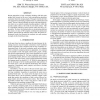Free Online Productivity Tools
i2Speak
i2Symbol
i2OCR
iTex2Img
iWeb2Print
iWeb2Shot
i2Type
iPdf2Split
iPdf2Merge
i2Bopomofo
i2Arabic
i2Style
i2Image
i2PDF
iLatex2Rtf
Sci2ools
CSL
2004
Springer
2004
Springer
Arc minimization in finite-state decoding graphs with cross-word acoustic context
Recent approaches to large vocabulary decoding with finite state graphs have focused on the use of state minimization algorithms to produce relatively compact graphs. This paper extends the finite state approach by developing complementary arc-minimization techniques. The use of these techniques in concert with state minimization allows us to statically compile decoding graphs in which the acoustic models utilize a full word of cross-word context. This is in significant contrast to typical systems which use only a single phone. We show that the particular arc-minimization problem that arises is in fact an NP-complete combinatorial optimization problem, and describe the reduction from 3-SAT. We present experimental results that illustrate the moderate sizes and runtimes of graphs for the Switchboard task.
| Added | 17 Dec 2010 |
| Updated | 17 Dec 2010 |
| Type | Journal |
| Year | 2004 |
| Where | CSL |
| Authors | François Yvon, Geoffrey Zweig, George Saon |
Comments (0)

